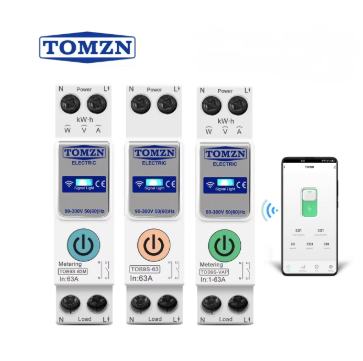Understanding Power Transfer Technology in Modern Electrical Systems
Power reliability has become increasingly critical in our interconnected world. At the heart of backup power systems lies the automatic transfer switch, a sophisticated device that seamlessly transitions between power sources during outages. This essential component ensures continuous power supply for homes, businesses, and critical facilities, making it an indispensable part of modern electrical infrastructure.
The automatic transfer switch represents a significant advancement in power management technology, offering protection against costly downtime and potential damage to sensitive equipment. As our dependence on uninterrupted power continues to grow, understanding these systems becomes crucial for facility managers, homeowners, and industry professionals alike.
Core Components and Functionality
Primary System Architecture
The automatic transfer switch consists of several sophisticated components working in harmony. At its core, you'll find the main switching mechanism, typically comprising robust electrical contacts designed to handle high current loads. The control module serves as the brain of the system, constantly monitoring power conditions and making split-second decisions about when to initiate transfers.
Supporting these primary elements are voltage sensors, timing devices, and sophisticated microprocessors that ensure precise operation. Modern switches also incorporate advanced features like programmable setpoints, communication interfaces, and diagnostic capabilities that enhance their functionality and reliability.
Operating Mechanisms and Control Systems
The control system of an automatic transfer switch employs advanced algorithms to monitor both the primary and secondary power sources. When it detects a power anomaly in the primary source, such as a complete failure or voltage fluctuation beyond acceptable parameters, it initiates a precisely timed transfer sequence.
This sequence includes critical safety checks, proper timing delays, and synchronized switching to prevent damage to connected equipment. The system must also ensure that the backup power source is stable and ready before completing the transfer, all while maintaining strict adherence to electrical codes and safety standards.
Implementation and Installation Considerations
Site Assessment and Planning
Successful implementation of an automatic transfer switch begins with thorough site evaluation. Factors such as available space, existing electrical infrastructure, and specific load requirements must be carefully assessed. Engineers must consider the physical location, environmental conditions, and accessibility for maintenance when planning the installation.
The planning phase should also account for future expansion needs, potential system upgrades, and compliance with local electrical codes. This forward-thinking approach ensures the installation will serve its purpose effectively while maintaining flexibility for future modifications.
Technical Requirements and Standards
Installation must adhere to strict technical specifications and industry standards. This includes proper sizing of the automatic transfer switch based on the total connected load, voltage requirements, and switching speed needs. The installation team must ensure proper clearances, ventilation, and protection from environmental factors.
Additionally, the system must be integrated with existing electrical infrastructure, including coordination with circuit breakers, emergency power sources, and building management systems. Proper grounding and surge protection measures are essential for reliable operation and safety compliance.
Maintenance and Performance Optimization
Preventive Maintenance Protocols
Regular maintenance is crucial for ensuring the reliable operation of an automatic transfer switch. This includes periodic inspection of electrical contacts, control system testing, and verification of timing sequences. Maintenance technicians should check for signs of wear, loose connections, or environmental damage that could affect performance.
Documentation of maintenance activities, including test results and any adjustments made, helps track system health over time. Many modern switches include self-diagnostic capabilities that can alert maintenance teams to potential issues before they become critical problems.
Performance Monitoring and Optimization
Ongoing monitoring of automatic transfer switch performance helps identify opportunities for optimization. This includes analyzing transfer times, reviewing event logs, and assessing power quality metrics. Advanced monitoring systems can provide real-time data and historical trending information for comprehensive system analysis.
Regular performance reviews enable facility managers to make informed decisions about system upgrades or modifications. This proactive approach helps maintain optimal functionality while extending the service life of the equipment.
Future Trends and Technological Advances
Smart Integration and Connectivity
The evolution of automatic transfer switch technology continues with enhanced connectivity and integration capabilities. Modern systems increasingly incorporate IoT features, allowing remote monitoring and control through secure network connections. This connectivity enables predictive maintenance strategies and more efficient system management.
Integration with building automation systems and energy management platforms provides comprehensive power control solutions. These advanced features help organizations optimize their power usage while maintaining reliable backup power capabilities.
Emerging Technologies and Innovations
Recent innovations in automatic transfer switch design focus on improving efficiency and reliability while reducing environmental impact. New materials and manufacturing techniques are producing more compact and efficient switches. Advanced control algorithms are enabling faster, more precise transfers while minimizing stress on connected equipment.
The industry is also seeing development in hybrid systems that can manage multiple power sources, including renewable energy integration. These advancements are paving the way for more flexible and sustainable power management solutions.
Frequently Asked Questions
How long does an automatic transfer switch typically last?
The lifespan of an automatic transfer switch typically ranges from 15 to 20 years when properly maintained. However, this can vary depending on environmental conditions, frequency of operation, and maintenance quality. Regular servicing and timely replacement of worn components can extend this lifespan significantly.
What maintenance does an automatic transfer switch require?
Regular maintenance includes visual inspections, cleaning, testing of control systems, and verification of proper operation. Key maintenance tasks should be performed annually, including checking electrical connections, lubricating moving parts, and testing transfer sequences. More frequent inspections may be necessary in harsh environments or critical applications.
Can an automatic transfer switch be installed in any electrical system?
While automatic transfer switches are versatile, their installation must be carefully planned and executed by qualified professionals. The system must be properly sized for the electrical load, comply with local codes, and be compatible with existing infrastructure. A thorough site assessment and professional engineering review are essential for successful implementation.
